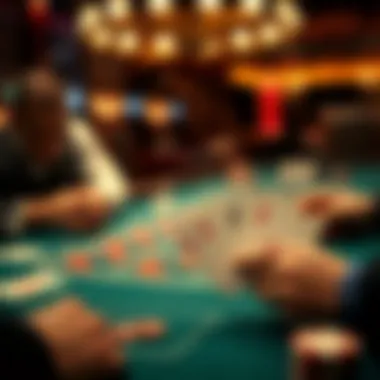Exploring Bets in Three Card Poker: Strategies and Rewards


Intro
Three Card Poker has carved out its niche in the vibrant world of casino games. Its blend of simplicity and strategy draws gamblers from all walks of life. But beyond flashy cards and betting chips lies a nuanced system of bets, each brimming with its own potential outcomes and hazards. Understanding these betting options is crucial for anyone looking to step up their game or better comprehend the dynamics at play around the poker table.
In this article, we'll take a detailed look into the betting landscape of Three Card Poker. We will cover the core mechanics that govern the game, the available bet types, and the strategic considerations that can influence a player's success. With every bet, there is a risk, and with every risk, a potential reward. As we peel back the layers of this exciting game, players will be better equipped to make informed choices at the table.
Prelude to Three Card Poker
When it comes to understanding Three Card Poker, there’s more to the game than simply dealing three cards and laying down bets. This game carves its niche in the bustling world of casinos, mesmerizing players with its combination of strategy, luck, and rapid gameplay. Grasping the intricacies of Three Card Poker can not only enhance your experience but also significantly influence your chances of winning.
At the heart of the mundane gameplay lies a strategic dimension that can’t be overlooked. The way you approach bets and decisions can define your success at the felt. Gamblers must consider not only the odds but also how each bet aligns with their playing style. Furthermore, learning the rules will boost confidence, encouraging players to make informed choices.
Origins of the Game
Three Card Poker made its debut in the early 1990s, crafted by the creative minds of David Sklansky and the company Shuffle Master. Originally, its arrival was celebrated more for adding a refreshing twist to the poker formula than for its depth. The game’s essence resides in its simplicity, allowing new players to grasp concepts easily while still providing layers of tactical complexity for the seasoned gambler.
Despite its relatively recent origin, the game draws from traditional poker elements, providing a familiar yet distinct gaming experience. The blend of community and individual gameplay has blossomed across various casinos worldwide, solidifying its status as a favorite among both amateurs and professionals.
Game Mechanics
Diving deeper into the game mechanics, Three Card Poker combines elements from poker and a house-banked game. Players aim to make the best hand possible out of three cards dealt to them while also engaging with the dealer. It’s like a dance between skill and chance. After the cards are dealt, players must decide whether to call or fold based on their hands in relation to the dealer's.
The hand rankings in Three Card Poker differ slightly from traditional poker. For instance, a straight beats a flush, which can often throw new players off. As it stands, the order of strength begins with a high card, proceeding through pairs, flushes, straights, and ultimately reaching a straight flush.
Each hand is a fresh start, and knowing the rules gives players an edge. The mechanics are straightforward: players place their ante bet, receive cards, and then engage in the decision-making process based on what they’ve been dealt. This particular structure fosters fast-paced action, creating an exhilarating environment that keeps players on their toes.
In summary, understanding these foundational elements lays the groundwork for further exploration into the betting options and strategies central to Three Card Poker. The more you know, the better your chances of staying ahead in this intriguing card game.
Overview of Betting Options
When diving into the world of Three Card Poker, understanding the varying betting options is absolutely vital for anyone who wants to play smarter and maximize their potential returns. Armed with knowledge about the bets you can place, players can tailor their strategies to match their comfort levels and goals. In Three Card Poker, three primary betting options emerge: the Ante Bet, the Play Bet, and the Pair Plus Bet. Each brings its own unique flavor to the gameplay and potentially shifts the odds, which can either tip the scales in favor of the house or the player.
Considering the nuances of each option not only heightens the gaming experience but also cultivates informed decision-making. Let’s dive into the specifics of each betting option, exploring what makes them distinctive, the risks involved, and how one can engage with them effectively, all while keeping an eye on the long-term strategy.
Ante Bet
The Ante Bet is the cornerstone of starting a hand in Three Card Poker. This bet serves as an initial wager before players know what cards they’re dealt. By placing an Ante Bet, players signal their willingness to proceed in the round, effectively purchasing a seat at the table with hopes of making a strong hand.
In this context, let’s break down how the Ante Bet works:
- Initial Commitment: The Ante Bet is mandatory, setting the stage for the rest of the game. You can't jump in without this fundamental stake.
- Deciding to Play: After seeing your cards, you must choose whether to continue with the Play Bet or fold. This decision hinges on factors like the strength of your hand.
- Winning the Ante: If you opt to stay in and beat the dealer’s hand or if the dealer doesn’t qualify, you're in for a nice return.
The beauty of the Ante Bet lies in its simplicity and the strategic layer it brings to the game. It encourages players to think critically, weighing the risks versus the benefits of their immediate situation.
Play Bet
Once you’ve placed the Ante Bet and assessed your hand, you then consider the Play Bet. Unlike the Ante, which is a must-do to enter, this bet depends on your confidence in your hand after the initial reveal. If you believe your cards can hold up against the dealer’s, placing a Play Bet becomes essential.
Here’s how it typically breaks down:
- When to Place: Players must make the Play Bet equal to their Ante Bet once they decide to stay in the game. This means commitment, as it doubles your potential stake in that round.
- Payout Context: If your hand beats the dealer’s, the Play Bet can lead to a nice return. It’s not merely about winning; the payout structure adds a layer of excitement.
- Dealer Qualification: The dealer needs a qualifying hand to pay out any winnings. If their hand fails to meet the threshold, the player wins based solely on their Ante Bet.
The Play Bet can enhance the adrenaline rush of the game. It’s essential to decide quickly but wisely, as sinking more into it puts your gut feeling to the test.
Pair Plus Bet


Finally, we arrive at the Pair Plus Bet—a unique option that offers a different avenue for payout based purely on the strength of your hand, regardless of the dealer’s outcome. This bet stands out because it caters to players who are more inclined toward higher payouts for decent card combinations, even if they don’t win against the dealer.
Consider these aspects of the Pair Plus Bet:
- Independence from Dealer’s Hand: Unlike the Ante and Play Bets that depend on the dealer’s hand, the Pair Plus focuses solely on what you hold. If your cards land a pair or better, there’s a payout waiting.
- Risk Versus Reward: The returns are appealing, but the bet has higher house odds compared to the Ante and Play. So, knowing when to engage with this bet can pay off, or it can leave you on the losing end.
- Excitement Factor: This bet often brings a heightened thrill to the game, as players can strike it lucky with various hands, bringing a different strategic twist to the table.
In wrapping up this exploration of betting options, each with its own appeal and challenges, it’s clear that a sound understanding goes a long way in any game of Three Card Poker. The blend of risk and strategy not only creates a fascinating engagement with the game but also allows players to refine their approaches based on their knowledge of how bets interact and influence outcomes. For a comprehensive strategy, grasping these betting options is indispensable!
Understanding the Ante Bet
The Ante Bet serves as the cornerstone of Three Card Poker, acting as the initial wager that players must place to participate in a hand. Grasping this bet's intricacies is vital for understanding the game, as it lays the groundwork for further betting decisions and strategic maneuvers. Essentially, the Ante Bet tests a player’s hand strength before seeing the cards, creating both anticipation and an opportunity for risk measurement.
Additionally, this bet is not just about feeding the pot; it serves as a psychological tool, encouraging players to evaluate their odds in relation to what may be displayed on the table. By comprehending the Ante Bet’s mechanics and implications, players can devise stronger strategies that not only optimize their enjoyment but also enhance their chances of walking away with winnings.
How It Works
When a player chooses to make an Ante Bet, they put a specified amount of money on the table before receiving their cards. This bet is essentially a gamble on the strength of what they might be dealt. After placing the Ante, the dealer will hand out three cards to each player. The game uses a standard 52-card deck, and the central premise revolves around having a higher-ranking hand than the dealer's.
Once the cards are revealed, the player has a pivotal choice to make: continue with a Play Bet, matching the Ante, or fold, forfeiting their bet. This decision is significant because it can either lead to a greater payout if the player wins or result in a loss if they choose poorly. Therefore, understanding the outcomes and assessing the strength of their hand must inform this choice.
"The Ante Bet is your leap of faith, deciding whether to stick around or bail based on the hand you’re dealt."
Risk and Reward Assessment
Engaging in the Ante Bet encapsulates a delicate balance of risk and reward. The player is wagering without knowledge of their potential hand's strength, which inherently elevates the level of risk involved. However, the allure of a matching payout can be compelling. If a player wins against the dealer, they not only regain their Ante but can oftentimes hit a multiplier on their wager based on the hand's rank.
There are various aspects to consider when evaluating this bet:
- Odds of Winning: Statistically, players are likely to win against the dealer's hand about 50% of the time, depending on the strategy employed.
- Payout Gradient: Generally speaking, the Ante Bet doesn’t yield immediate returns unless the hand beats the dealer’s.
- Psychological Impact: Committing to the Ante can induce stress or anxiety but can also provide exhilarating moments of triumph during wins.
In summary, the Ante Bet is more than just a prerequisite for playing; it is a dynamic element of strategy that invites players to engage in a process of weighing potential gains against their willingness to risk. Ignoring its significance can lead to missed opportunities, whereas a keen understanding of its mechanics and implications can amplify one’s gaming experience.
Exploring the Play Bet
The Play Bet is an essential component in the dynamics of Three Card Poker, representing a pivotal moment where players must make crucial decisions post-flop. This bet not only carries significant implications for the game outcome but also affects how strategies unfold. Understanding the intricacies of the Play Bet can ultimately enhance a player’s ability to maximize potential returns while navigating the complexities of gameplay.
Conditions for Placing the Bet
In the world of Three Card Poker, the Play Bet cannot just be placed whimsically; it hinges on a few key conditions that players must be aware of. After receiving their three cards and making the initial Ante Bet, players must evaluate their hand against the dealer’s cards, which remain concealed until the end of the round. Here are the primary conditions that guide this bet:
- Hand Evaluation: A player must assess whether their hand is strong enough to warrant a Play Bet. Typically, a hand containing a Queen-high or better is seen as a reasonable threshold for proceeding.
- Timing: Players must act quickly after the dealer reveals their hand. The decision to place a Play Bet or fold must be made against the dealer's hand while considering the potential to win.
- Dealer Qualification: It’s crucial to remember that the dealer must qualify with at least a Queen-high for the player to potentially win the Play Bet. If the dealer does not qualify, any winning Ante Bet will be paid out, but the Play Bet is returned to the player.
Through this understanding of the Play Bet conditions, players can make more calculated choices, weighing the strength of their cards against the risks of continuing in the game.
Payout Structure
The payout structure of the Play Bet is another important aspect that deserves attention. Unlike some other casino games where payout ratios can be convoluted, the structure in Three Card Poker is rather straightforward but varies slightly based on specific scenarios:
- Winning Play Bet: If your hand beats the dealer's qualifying hand, your Play Bet typically pays even money, meaning a one-to-one payout.
- Winning Ante Bet: In cases where the player's hand also qualifies, the player could end up winning on both bets (Ante and Play). The Ante Bet payout could be enhanced with additional bonuses for higher-ranking hands, promoting a rewarding gaming experience.
- Ties: If both the player's and dealer's hands are tied, the Play Bet is a push, meaning it neither wins nor loses. It is returned to the player.
This clarity in the payout structure leads to a deeper understanding of risk and reward, guiding players in their decision-making processes. Keeping a handle on expected returns helps players balance their strategy with their bankroll effectively.
"Understanding the Play Bet is like holding the ace up your sleeve; it gives you the confidence to strategize your moves wisely."
By mastering the Play Bet mechanics, players position themselves to improve their outcomes while enhancing the overall Three Card Poker experience. Knowing when to place this bet and understanding its potential rewards can turn the tide in one's gaming strategy.
The Pair Plus Bet Explained


The Pair Plus bet stands as a distinctive feature of Three Card Poker, catering to a genre of gamblers who relish the thrill of betting on their hand’s potential rather than the dealer's hand. This aspect significantly enhances the game experience, adding another layer of strategy and engagement. Understanding this bet means recognizing not just the mechanics but also the broader implications for one’s gaming tactics and outcomes.
Betting Mechanics
When initiating a Pair Plus bet, players are wagering that their dealt three cards form at least a pair. Interestingly, the allure of this bet lies in its simplicity while also being deceptively multifaceted. It operates independently from the traditional Ante and Play bets, thereby focusing solely on the player's hand.
Here's how a typical process unfolds:
- Placement: As the cards are dealt, players place their wagers on the Pair Plus betting area on the table, typically adjacent to their Ante bet.
- Card Evaluation: After receiving their cards, if players have a pair or better, they win. It’s worth noting that a straight and flush also yield higher payouts, thus enticing players.
- Payout Determination: Payouts for the Pair Plus bet vary depending on the strength of the hand. For instance, a straight may return 1:1, while a three of a kind might net 30:1. The table of payouts usually displays these figures clearly.
In practical play, establishing a strategy around the mechanics can be vital. Players often analyze what constitutes a winning hand and adjust their betting size accordingly, thereby enhancing their potential returns.
Probabilities and Odds
The essence of mastering the Pair Plus bet lies in understanding the probabilities and the odds that accompany it. Many novice gamblers might find the odds intimidating at first glance, but breaking it down can offer clarity.
The calculations reveal that:
- Winning Hands: To land a winning hand with Pair Plus, the likelihood of obtaining a pair or better hovers around 25%. This statistic, while encouraging, underscores the inherent risk involved.
- House Edge: The house edge for the Pair Plus bet typically ranges between 2.32% and 7.28%, depending on the casino rules—this is a crucial detail for strategic planning. Lower house edges are preferable for players seeking to extend their playtime.
Furthermore, understanding how certain hands stack against others can significantly impact decision-making. For example, when considering the chances of getting a flush compared to three of a kind, players can gauge where bets are best placed.
"To pass up on the Pair Plus bet means to overlook an opportunity with unique dynamics that other bets within the game do not provide."
Getting comfortable with these numbers will allow gamblers to tailor their betting strategies. Whether to go all in or play it cautious can become a clear decision when armed with the right knowledge.
Comparative Analysis of Bets
Understanding the intricate dynamics of bets in Three Card Poker is essential for any player looking to enhance their overall strategy. This comparative analysis serves as a pivotal part of your journey through the game, unpacking the varying characteristics of each bet type and helping you make informed decisions that align with your gaming style. From the house edge to individual strategies, this section lays out the fundamental aspects that can dramatically affect your experience at the table.
House Edge Overview
When discussing betting in Three Card Poker, the house edge stands out as a critical factor. The house edge is essentially the casino's built-in advantage in each game, expressed as a percentage of total bets. Different bets attract different house edges, making it important for players to understand how these percentages can impact long-term play.
- Ante Bet: The house edge for the ante bet is around 3.5%. This modest rate makes it a popular choice among players who favor a balanced approach and wish to preserve their bankroll over time.
- Play Bet: The play bet mirrors the ante bet’s edge of approximately 3.5%, maintaining fairness for every player involved during the game.
- Pair Plus Bet: This bet introduces a higher house edge, estimated at about 7.28%. Though the potential payouts are often more attractive, the odds are consequently stacked against the player.
Understanding these differences can greatly influence your play style, allowing you to weigh potential rewards against the inherent risks involved.
"In gambling, absolute knowledge can only take you so far; it’s the balance of risk and strategy that decides victories."
Best Strategies for Each Bet
Effectively navigating Three Card Poker’s betting landscape requires tailored strategies for each type of bet. Here’s a breakdown of the most effective approaches.
- Ante Bet Strategy: A sound strategy could involve adhering closely to the dealer’s qualifying hands. If the dealer has a qualifying hand, it’s wise to play. However, if not qualified, folding after the ante bet minimizes losses.
- Play Bet Strategy: Here, sticking closely to the ante bet’s guidelines remains essential. Specifically, consider only playing when your hand ranks well on a straight or better. This limits risk while optimizing payout opportunities.
- Pair Plus Bet Strategy: With this bet type, looking for pair combinations (or higher) is key. Here, one may be more aggressive in placing bets, particularly in a good run. However, recognizing the risk associated with this higher edge can help you avoid significant losses.
Equipped with these strategies, you can balance your gameplay approach while maximizing your potential returns. The ultimate goal is to cultivate a deep understanding of how each bet functions within the context of the game itself.
Psychological Aspects of Betting
Understanding the psychological aspects of betting, especially in a game like Three Card Poker, is paramount for both players and operators alike. The dynamics of the human mind play a significant role in how bets are placed, perceived, and whether or not they yield favorable outcomes. It's more than just statistics and probabilities; players are often influenced by their emotions and cognitive biases, leading to decisions that may not always align with logical play or long-term strategies.
Decision-Making Processes
The decision-making process in Three Card Poker can be complex. Players have to evaluate multiple factors at once: the strength of their hand, potential outcomes, and the betting patterns of other participants. Emotions can cloud judgment, leading someone to chase losses or stake more than they intended in hopes of a comeback. Cognitive shortcuts often emerge, examples being overconfidence when holding a good hand or underestimating a poor one.
"In the heat of the moment, the mind can trick you into believing you're on a winning streak, even when the odds don't back you up."


To mitigate poor decision-making, players might consider several strategies:
- Self-awareness: Recognizing emotional triggers can help maintain composure.
- Game knowledge: Familiarity with the rules and strategies can bolster confidence.
- Practice: Simulations or smaller stakes can help with honing decision-making without high risks.
Each decision influences the following moves and can set off a chain reaction of choices down the line. Therefore, maintaining clarity under pressure is crucial for success in Three Card Poker. The ability to evaluate hands and make informed bets leads to more calculated risks, which is essential when the stakes are high.
Impact of Risk Tolerance
Risk tolerance is a vital element that shapes a player's betting behavior. It is pivotal to understand how a player's comfort with risk can affect their gameplay and overall experience. Some players dive in headfirst, eager to embrace the risk, whereas others might tiptoe around, placing conservative bets until they feel more secure.
Factors that influence risk tolerance include:
- Personal background: Previous experiences with gambling can shape how one views risk.
- Financial situation: A player's ability to handle losses varies dramatically among individuals.
- Social influences: Friends and peers can also impact one's comfort with risk; sometimes, the thrill of the game is contagious.
Those who embrace risk may often enjoy higher potential rewards, yet they run the danger of severe losses as well. On the other hand, players with a low risk tolerance might miss out on lucrative opportunities but preserve their stake longer. Striking a balance between cautious play and daring bets may require experimentation, but understanding one’s own risk appetite is crucial for longevity in the game.
In summary, acknowledging these psychological elements can enhance not just individual gameplay but also contribute to a more engaging and responsible gambling environment. For additional information, players can explore resources like Wikipedia on Gambling Psychology and forums on Reddit's Gambling Community.
Common Mistakes in Three Card Poker
Understanding common mistakes in Three Card Poker can significantly enhance a player’s experience and potential for success. The dynamics of the game, which blends strategy and luck, often lead players to make decisions that stem from misconceptions or lack of knowledge. By identifying these missteps, both novice and seasoned gamblers can not only improve their gameplay but also manage their wagers more effectively. This section sheds light on some frequent pitfalls that players encounter.
Underestimating the Odds
Many players step up to the table thinking they have a handle on the odds, only to find themselves caught in a web of bad decisions later on. One of the key things about Three Card Poker is understanding that the house edge is ever-present but varies across different betting options. For instance, the Pair Plus bet, while offering the allure of high payouts, also carries a significant risk given its odds of winning are lower compared to the ante bet.
Players often forget that each bet has its own set of probabilities. A full grasp of these odds can guide you toward making more informed choices during gameplay. Did you know that the chance of being dealt a flush in Three Card Poker, for instance, is a mere 5.2%? That’s a stark contrast to the common misconception that it's easy to hit. Misjudging what this means can lead to overly aggressive betting, potentially jeopardizing one's bankroll.
"In poker, the better you understand the odds, the less chance you have of losing your shirt at the table."
It's crucial to perform a risk/reward analysis before diving headfirst into a bet. Many gamblers tend to rely on luck, while others fall into the trap of chasing losses. Take a moment to crunch the numbers. Are you betting based on emotion or solid information?
Betting Misconceptions
Betting misconceptions are among the most subtle yet damaging mistakes players can make in Three Card Poker. One common myth is the idea that the dealer's hand can influence the outcomes of a player’s hand. Newcomers often think that if the dealer has a strong hand, then they should avoid playing—this couldn't be further from the truth. The dealer’s success doesn't determine yours directly; each hand is an independent event based on probability.
Another notable misconception involves the relationship between the size of one's bet and the likelihood of winning. Players sometimes assume that larger bets automatically translate to higher returns. In reality, even the smallest bets can yield sizable winnings if the cards fall in your favor. Betting more doesn’t improve your hand odds; it merely ups the ante.
Instead of getting swept away by myths, it’s smarter to focus on logical strategies. Familiarize yourself with the game by practicing, analyzing your results, and learning from the situations you encounter. Remember, understanding how bets correlate with odds and house edge will contribute immensely to your long-term success in the game.
Finale and Best Practices
In wrapping up our exploration of Three Card Poker, it’s essential for both enthusiasts and novices alike to grasp the importance of betting strategies and their underpinning theories. Adopting a structured approach to betting not only enhances one’s gaming skills but also deepens the understanding of the mechanics involved. This multifaceted game, while straightforward in its rules, harbors nuances that can greatly influence the outcome for the player.
The insights from this article aim to furnish readers with practical knowledge that can steer their betting decisions effectively. In particular, focusing on the different bets and their respective impacts aims at maximizing the chances of winning. Knowing when to place an ante bet or a Pair Plus bet hinges on understanding the odds—an idea we have pushed throughout this discussion.
Most importantly, being aware of common pitfalls can trim away unnecessary losses. A player likely loses out when they become too confident or miss crucial aspects of the game’s dynamics. Thus, practice—whether through real gameplay or simulations—plays a vital role in refining strategy. With each hand, there's an opportunity for learning and improving your approach.
"In the game of chance, preparation meets opportunity."
Summarization of Key Points
- Types of Bets Explained: We examined the Ante Bet, Play Bet, and Pair Plus Bet, detailing how each works and why players might opt for one over the others.
- Risk Assessment and Probability: Understanding the house edge for various bets equips players with the knowledge to make informed decisions. Different strategies can tilt the odds in their favor.
- Psychological Elements: Decisions at the blackjack table are often impacted by emotions, and managing your mindset could be just as crucial as understanding the rules.
- Common Mistakes: A checklist was provided on common missteps players make, helping to steer clear of them significantly boosts the chances of success.
By synthesizing this information, players have a roadmap to follow, potentially leading to improved gaming outcomes and a more enjoyable experience in the long run.
Final Thoughts on Betting Strategy
As you sit at the table ready to place your bets, remember that strategy is as essential as luck. Whether aiming for the best payout or simply wishing to enjoy the game, having a solid understanding of the betting options gives you a fighting chance. Let’s face it—the game is about more than just placing bets every hand; it’s a mental duel against probabilities and often, against other gamblers.
Thus, multifaceted strategies tailored to your gameplay style and risk appetite can change the landscape of your game significantly. Experimenting with different bets in varying situations lets you gauge what works best for you.
In the end, while the jackpot may wave a tempting hand, patience and wisdom in your approach often yield the best rewards. So, shuffle the cards, place your bets with care, and enjoy the thrilling ride that is Three Card Poker.







